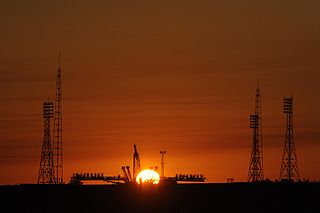
A spaceport or cosmodrome is a site for launching or receiving spacecraft, by analogy to a seaport for ships or an airport for aircraft. The word spaceport, and even more so cosmodrome, has traditionally been used for sites capable of launching spacecraft into orbit around Earth or on interplanetary trajectories. However, rocket launch sites for purely sub-orbital flights are sometimes called spaceports, as in recent years new and proposed sites for suborbital human flights have been frequently referred to or named "spaceports". Space stations and proposed future bases on the Moon are sometimes called spaceports, in particular if intended as a base for further journeys.
Orbital Sciences Corporation was an American company specializing in the design, manufacture and launch of small- and medium- class space and launch vehicle systems for commercial, military and other government customers. In 2014, Orbital merged with Alliant Techsystems to create a new company called Orbital ATK, Inc., which in turn was purchased by Northrop Grumman in 2018. The remnants of the former Orbital Sciences Corporation today are a subsidiary of Northrop Grumman known as Northrop Grumman Space Systems.
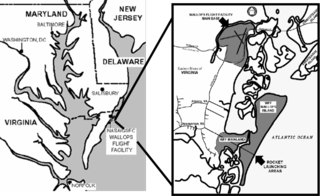
Wallops Flight Facility (WFF) is a rocket launch site on Wallops Island on the Eastern Shore of Virginia, United States, just east of the Delmarva Peninsula and approximately 100 miles (160 km) north-northeast of Norfolk. The facility is operated by the Goddard Space Flight Center in Greenbelt, Maryland, and primarily serves to support science and exploration missions for NASA and other Federal agencies. WFF includes an extensively instrumented range to support launches of more than a dozen types of sounding rockets; small expendable suborbital and orbital rockets; high-altitude balloon flights carrying scientific instruments for atmospheric and astronomical research; and, using its Research Airport, flight tests of aeronautical research aircraft, including unmanned aerial vehicles.

The Mid-Atlantic Regional Spaceport (MARS) is a commercial space launch facility located at the southern tip of NASA's Wallops Flight Facility on Wallops Island in Virginia, just east of the Delmarva Peninsula and south of Chincoteague, Virginia, United States. It is owned and operated by the Virginia Commercial Space Flight Authority.

Antares, known during early development as Taurus II, is an expendable launch system developed by Orbital Sciences Corporation and the Yuzhnoye Design Bureau to launch the Cygnus spacecraft to the International Space Station as part of NASA's COTS and CRS programs. Able to launch payloads heavier than 8,000 kg (18,000 lb) into low Earth orbit, Antares is currently the largest rocket operated by Northrop Grumman. Antares launches from the Mid-Atlantic Regional Spaceport and made its inaugural flight on April 21, 2013.

Cygnus is an expendable American cargo spacecraft developed by Orbital Sciences Corporation and now manufactured and launched by Northrop Grumman Space Systems as part of NASA's Commercial Resupply Services (CRS) program. It is launched by Northrop Grumman's Antares rocket or ULA's Atlas V and is designed to transport supplies to the International Space Station (ISS) following the retirement of the American Space Shuttle. Since August 2000, ISS resupply missions have been regularly flown by the Russian Progress spacecraft, as well as by the European Automated Transfer Vehicle, and the Japanese H-II Transfer Vehicle. With the Cygnus spacecraft and the SpaceX Dragon, NASA seeks to increase its partnerships with domestic commercial aviation and aeronautics industry.

Launch Pad 0 (LP-0), also known as Launch Complex 0 (LC-0), or Launch Area 0 (LA-0), is a launch complex at the Mid-Atlantic Regional Spaceport (MARS) on Wallops Island, Virginia in the United States. MARS is located adjacent to NASA's Wallops Flight Facility (WFF), which ran the launch complex until 2003. WFF continues to provide various support services to MARS launches under contract with the Commonwealth of Virginia.

Rocket Lab is a public American aerospace manufacturer and launch service provider, with a New Zealand subsidiary. The company operates lightweight Electron orbital rockets, which provide dedicated launches for small satellites. Rocket Lab also plans to build a larger Neutron rocket as early as 2024. Electron rockets have launched 26 times from either Rocket Lab's Launch Complex 1 in New Zealand or the Mid-Atlantic Regional Spaceport in the United States. Two attempts have been made at recovery of the Electron booster. As of 2022, Rocket Lab is developing the bigger Neutron reusable unibody rocket; Photon satellite buses; and Rutherford, Curie, HyperCurie, and Archimedes rocket engines.

Orbital-1, also known as Orb-1, was the second flight of the Orbital Sciences Cygnus cargo spacecraft, its second flight to the International Space Station (ISS) and the third launch of the company's Antares launch vehicle. The mission launched on 9 January 2014 at 18:07:05 UTC.

Orbital-2, also known as Orb-2, was the third flight of the Orbital Sciences' uncrewed resupply spacecraft Cygnus, its third flight to the International Space Station, and the fourth launch of the company's Antares launch vehicle. The mission launched from the Mid-Atlantic Regional Spaceport (MARS) on 13 July 2014 at 16:52:14 UTC.

Antares A-ONE mission was the maiden flight of Orbital Sciences Corporation' Antares launch vehicle including the ascent to space and accurate delivery of a simulated payload, the Cygnus Mass Simulator (CMS), which was launched 21 April 2013. It was launched from Pad 0A at the Mid-Atlantic Regional Spaceport (MARS), Wallops Flight Facility, Virginia. The simulated payload simulates the mass of the Cygnus cargo spacecraft. This dummy payload was sent into an orbit of 240 km × 260 km with an orbital inclination of 51.6°, the same launch profile it will use for Orbital's upcoming cargo supply missions to the International Space Station (ISS) for NASA.

Alexander, also known as PhoneSat 2.0 Beta or PhoneSat v2a is a technology demonstration satellite operated by NASA's Ames Research Center, which was launched in April 2013. Part of the PhoneSat programme, it was one of the first three PhoneSat spacecraft, and the first Phonesat-2.0 satellite, to be launched.
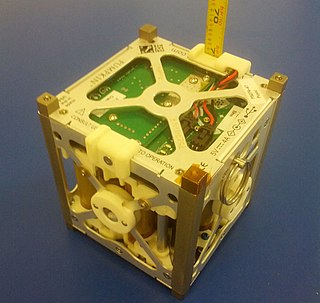
Graham, also known as PhoneSat 1.0a or PhoneSat v1a was a technology demonstration satellite operated by NASA's Ames Research Center, which was launched in April 2013. Part of the PhoneSat programme, it was one of the first three PhoneSat spacecraft to be launched.

Orbital-3, also known as Orb-3, was an attempted flight of Cygnus, an automated cargo spacecraft developed by United States-based company Orbital Sciences, on 28 October 2014. The mission was intended to launch at 22:22:38 UTC that evening. This flight, which would have been its fourth to the International Space Station and the fifth of an Antares launch vehicle, resulted in the Antares rocket exploding seconds after liftoff.
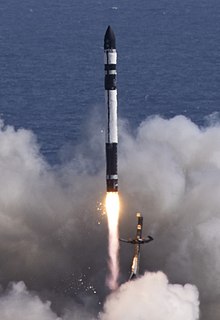
Electron is a two-stage, partially recoverable orbital launch vehicle developed by Rocket Lab, an American aerospace company with a wholly owned New Zealand subsidiary. Electron was developed to service the commercial small satellite launch market. Its Rutherford engines are the first electric-pump-fed engine to power an orbital-class rocket. Electron is often flown with a kickstage or Rocket Lab's Photon spacecraft. Although the rocket was designed to be expendable, Rocket Lab has recovered the first stage twice and is working towards the capability of reusing the booster. The Flight 26 (F26) booster has featured the first helicopter catch recovery attempt.
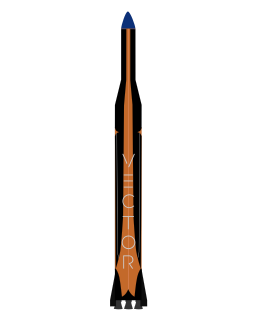
Vector-R is a two-stage orbital expendable launch vehicle under development by the American aerospace company Vector Launch to cover the commercial small satellite launch segment (CubeSats). Vector Launch went bankrupt in December 2019 and re-emerged in October 2020. Two prototypes were launched in 2017.

CAPSTONE is a lunar orbiter that will test and verify the calculated orbital stability planned for the Lunar Gateway space station. The spacecraft is a 12-unit CubeSat that will also test a navigation system that will measure its position relative to NASA's Lunar Reconnaissance Orbiter (LRO) without relying on ground stations. It was launched on 28 June 2022, arrived in lunar orbit on 14 November 2022, and is scheduled to orbit for six months.

NG-15, previously known as OA-15, was the fifteenth launch of the Northrop Grumman robotic resupply spacecraft Cygnus and its fourteenth flight to the International Space Station (ISS) under the Commercial Resupply Services (CRS) contract with NASA. The mission launched on 20 February 2021 at 17:36:50 UTC. This is the fourth launch of Cygnus under the CRS-2 contract.
Neutron is a medium-lift two-stage launch vehicle under development by Rocket Lab. Announced on 1 March 2021, the vehicle is being designed to be capable of delivering an 8,000 kg (17,600 lb) payload to low Earth orbit in a reusable configuration, and will focus on the growing megaconstellation satellite delivery market. The vehicle is expected to be operational sometime in 2024. It uses LOX and liquid methane propellant on both stages of the vehicle.


















